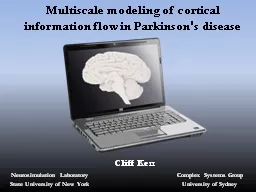

disease Cliff Kerr Complex Systems Group University of Sydney Neurosimulation Laboratory State University of New York Parkinsons disease Tremor typically 36 Hz Bradykinesia slowness of movement ID: 560242
Download Presentation The PPT/PDF document "Multiscale modeling of cortical informat..." is the property of its rightful owner. Permission is granted to download and print the materials on this web site for personal, non-commercial use only, and to display it on your personal computer provided you do not modify the materials and that you retain all copyright notices contained in the materials. By downloading content from our website, you accept the terms of this agreement.
Slide1
Multiscale modeling of cortical information flow in Parkinson's disease
Cliff Kerr
Complex Systems GroupUniversity of Sydney
Neurosimulation LaboratoryState University of New YorkSlide2Parkinson’s disease
Tremor (typically 3-6 Hz
)Bradykinesia (slowness of movement)Bradyphrenia (slowness of thought)Slide3
Spiking network model
Event-driven integrate-and-fire model6-layered cortex, 2 thalamic
nuclei15 cell types 5000 neuronsSlide4A
natomy & physiology based on experimental dataAdaptable to different brain regions based on cell populations/ connectivitiesModel generates realistic neuronal dynamics; demonstrated control of virtual arm
Synaptic input:
Synaptic plasticity:
Spiking network modelSlide5Spiking network model
Connectivity matrix based on rat, cat, and macaque data
Strong intralaminar and thalamocortical connectivity Slide6
Neural field model
Continuous firing rate model9 neuronal populations
26 connectionsField model activity drives network modelSlide7
Neurons averaged out over 1 mm, allowing the whole brain to be represented by a grid of nodesIncludes major cortical and thalamic cell populations,
plus basal gangliaDemonstrated ability to replicate physiological firing rates and spectra:Population firing response:
Transfer function:
Neural field modelSlide8Neural field model
GPi links basal ganglia to rest of brain:Slide9Firing rates in the field model drive an ensemble of Poisson processes, which then drive the network
From field to network
Network
Field
p
1
p
2
p
3
PoissonSlide10
Field model dynamics
PD disrupts coherence between basal ganglia nucleiPD changes spectral power in beta/gamma bandsSlide11
Network model dynamicsSlide12
Network spectraSlide13
Burst probabilitySlide14
Granger causalitySlide15Summary
Model can reproduce many features of Parkinson’s disease (e.g. reduced cortical firing, increased coherence)Granger causality between cortical layers was markedly reduced in PD – possible explanation of bradyphrenia (…and bradykinesia?)Different input drives had a
major effect on the model dynamicsWhere possible, realistic inputs should be used instead of white noise for driving network models Slide16
Acknowledgements
Sacha J. van Albada Samuel A. NeymotinGeorge
L. Chadderdon III Peter A. RobinsonWilliam W. Lytton